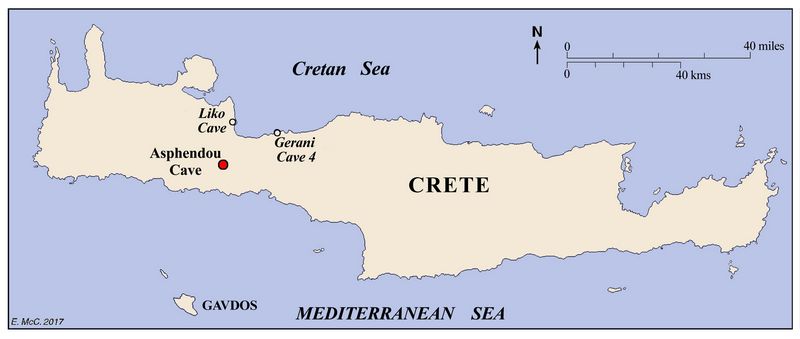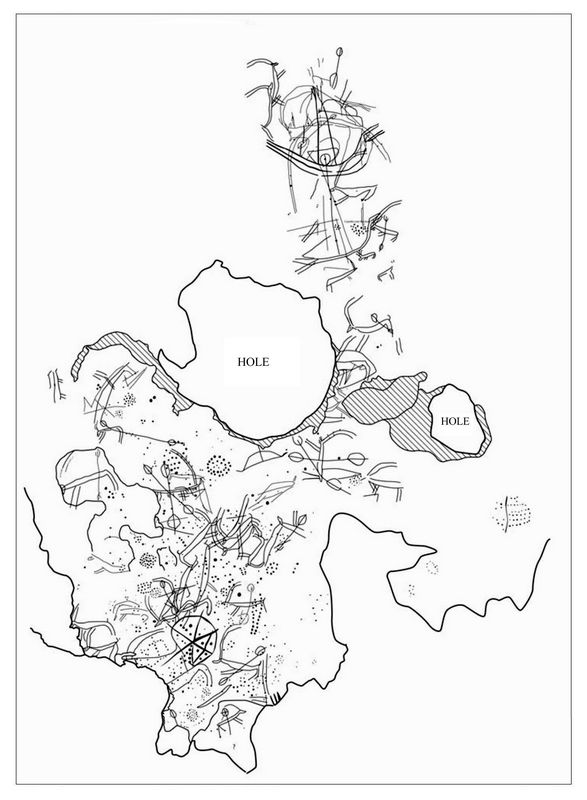Rust Family Foundation: Archaeology Grants Program
The Asphendou Cave Petroglyphs: A Stylistic and Photogrammetric Analysis
Principal Investigator: Thomas F. Strasser
Department of Art and Art History, Providence College
Importance of the research
Rock carvings (petroglyphs) at Asphendou Cave in west Crete show both geometric and figurative motifs. Use of accurate and detailed photogrammetric analysis of the petroglyphs resulted in identification of least 37 quadrupeds. These petroglyphs are the earliest example of figural art on Crete and in Greece.

Fig. 1: The location of Asphendou Cave and relevant paleontological sites where dwarf Candiacervus fossils were discovered. (E. McClellen)
Previous Research at the Site
The rock carvings (petroglyphs) at Asphendou Cave in west Crete were first published in the early 1970s. The petroglyphs comprise a variety of geometric and abstract motifs, as well as quadrupeds. Determining the absolute chronology of the engravings has proven problematic. The original publication posited a pre-Neolithic date (>6500 B.C.), but some scholars prefer a late Bronze Age or Minoan date (<3000 B.C.).

Fig.2: The rock carvings on the floor of Asphendou Cave. The deeper engravings of cupules were carved later than the shallow incisions of the quadrupeds. (S. Murray)
2016 Funded Research Project (RFF-2016-10)
Goals:
The purpose of new research in the cave was twofold: to document these puzzling engravings using up-to-date scientific methods of photography and illustration, and to re-evaluate the likely date of the engravings.
Methodologies:
Using photogrammetry, the project produced a detailed 3-D model of the flowstone where the engravings are carved. Although many of the glyphs are less than a millimeter deep, the model was able to capture the surface with .01 mm accuracy and capture even very subtle details. A metrically accurate orthophoto was generated from the 3-D model, and this was used to trace a new drawing of the petroglyphs (fig.3). This approach was advantageous because it yielded a more accurate and detailed drawing than could have been achieved using more traditional methods in the very shallow and awkward space of the cave.

Fig.3: The drawn petroglyphs (C. Kolb).
Results of the 2016 Project:
These detailed photographs were traced to produce drawings far more meticulous than was possible when previous scholars examined the cave in the early 1970s. Some incisions were carved later than others demonstrating a sequence of engravings which we drew level by level. We discovered four significant engraving events that we term levels. The closest analogy is a 'palimpsest' in stone.
Reanalyzing deer fossils from Liko and Gerani Caves demonstrate the thirty-seven quadrupeds in the basal level most closely resemble extinct Pleistocene dwarf deer (genus Candiacervus), and not the feral goat that was introduced to Crete ca. 7000 B.C. (agrimia Capra aegragus cretica) and a common motif in later Bronze Age (i.e., Minoan) art. Consequently, the basal level of the petroglyphs are Palaeolithic (>10,000 B.C.), and the earliest example of figural art on Crete and in Greece.
The Levels:
The four level that are recognized by the engraving sequence also have different corresponding tool marks and iconography.
Level 1:
In the top level are deeply carved ‘boat(s)’ and ‘starburst’. They are made from a tool with a deeper incision and different than the underlying levels.
Level 2:
A series of cupules arranged in various formations such a circles and spirals. The meaning of these are enigmatic. Similar cupules are found the islands of Andros, Naxos and Crete that are firmly dated to the Final Neolithic or the first phases of the Early Bronze Age (ca. 3500-2800 B.C). These provide a terminus ante quem (i.e., date before which) for the underlying petroglyphs. Consequently, Levels 3 & 4 date earlier.
Levels 3 & 4:
These basal levels are comprised of 37 quadrupeds with paddle shaped images crossing over them. In level 3 there are at least 17 paddle-shaped images whose interpretation remains enigmatic. They seem to be engraved by the same type of tool used for the quadrupeds in level 4. There is the correlation that most of them cross over a quadruped, which might suggest they are hunting implements.
The Identification of the quadrupeds in Level 4:
Our drawings of level 4 are the most significant. We recorded a herd of at least 37 quadrupeds, while earlier scholars could recognize 19-20 or 24-25. These quadrupeds are ruminants with cranial appendages that are long, generally weakly curved, and have different lengths relative to the body length. In some quadrupeds, the appendages run more horizontally, without change in angle, whereas others are short with a clear change in angle halfway. None of the appendages is scimitar-shaped like the modern feral goat (agrimia). The appendages are not forked, but smooth with no horizontal ridges.

Fig.4: Skull and antler of a dwarf Candiacervus.
Left: The antler, showing the slight curvature towards the anterior, is from Gerani Cave 4. This cave contains the geologically youngest Pleistocene fauna. The curved variety is found together at Gerani 4 with straighter varieties and belonged to the same dwarf Candiacervus ropalophorus. (S. Murray & A. van der Geer)
Right: Detail of one quadruped from level 4. (C. Kolb)
A brief history of feral and wild ungulates on Crete:
To contextualize the images of the quadrupeds it is important to consider the history of ungulates on Crete. In the late Pleistocene, or Upper Palaeolithic (ca. >10,000 B.C), there were seven to eight types of deer which are part of the genus Candiacervus. The largest have multi-tined antlers. Only the pygmy deer, Candiacervus ropalophorus, and a related species yet to be completely described and officially named, have singular, strangely elongated antlers, with one small brow tine.
The dwarf deer at the end of the Ice Age was ca. 40 centimeters tall at its shoulder as an adult. In contrast, it had unusually long antlers that curve gently backward. Dwarf terrestrial fauna are common in island environments. These are the prominent terrestrial fauna during the end of the Late Pleistocene or Upper Palaeolithic (ca. > 10,000 B.C.).
We have no faunal evidence from the Mesolithic on Crete (ca. 10,000-7000 B.C.). The faunal remains at Neolithic Knossos have the well-known introduced domesticates of sheep/goat, cattle and pig. Agrimia (Capra aegragus cretica) are feral forms of the introduced goat and cannot pre-date 7000 B.C., several thousand years after the extinction of the Candiacervus genus. In the Holocene (10,000 B.C.-present) there are Red and Fallow Deer, which have palmate or forked antlers.
Consequently, Candiacervus ropalophorus and agrimia (Capra aegragus cretica) are the only two species that could have such simple, undivided cranial appendages. Every quadruped with cranial appendages represents Candiacervus, and not Capra aegragus cretica. Consequently, they date earlier than the end of the Palaeolithic ca. >10,000 B.C.
Conclusions:
The lack of a ground-line in the rendering of the herd is very similar to Palaeolithic art seen elsewhere throughout the world. We have no depictions of quadrupeds in the Cretan Neolithic. The absence of a ground-line is very rare in Minoan art, where agrimia are replete as a subject matter.
Identifying the depicted species as Candiacervus ropalophorus has greater explanatory parsimony than positing a Minoan depiction of agrimia. It beggars belief that a Bronze Age artist made these basal carvings of agrimia and, with strangely peculiar artistic license, engraved all 37 of them with cranial appendages to look far more like Pleistocene Candiacervus antlers than agrimia horns. In addition, Candiacervus had been extinct for at least 7000 years by the Bronze Age, so the artist could not have seen them. The amount of special pleading needed to explain the quadrupeds as agrimia is greater than to describe them as Ice Age deer. Their morphologies in toto are far more comparable to the fossil evidence. Random artistic license cannot explain this, but the engravings are an attempt to replicate the surrounding landscape in the Upper Palaeolithic. In the case of Asphendou Cave, they are Late Pleistocene deer.
Team Members
Thomas F. Strasser
Department of Art and Art History, Providence College, 1 Cunningham Sq., Providence, RI 02918, USA
Sarah Murray
Department of Classics, University of Toronto, Lilian Massey Building, 125 Queen’s Park, Toronto, ON MSS 2C7, CANADA
Alexandra van der Geer
Department of Geology and Historical Geology, National and Kapodistrian University of Athens, Athens 157 84, GREECE, Naturalis Biodiversity Center, Leiden 2333 CR, the NETHERLANDS
Christina Kolb
11842 Broadwater Ln., Charlotte, NC 28273, USA
Louis A. Ruprecht Jr.
Department of Anthropology, Center for Hellenic Studies, Georgia State University, Box 5060 Atlanta, GA 30302-5060, USA
Publications concerning the petroglyphs:
Faure, P., 1972. Cultes populaires dans la Crète antique. B. Correspond. Hellénique 96, 389–426.
Hood, S., 1974. Primitive rock engravings from Crete. The J. Paul Getty Museum Journal 1, 101–111.
Papoutsakis, Ch., 1972. Οι βραχογραφίες στ᾽ Ασφέντου τῶν Σφακίων. Κρητικά Χρονικά 24, 107–139.
Tzedakis, Y., 1973. Τα Σκορδολάκκια. Αρχαιολογικόν Δελτίον 28 B’ 2-Χρονικά A, 583.
Zois, A., 1973a. À propos des gravures rupestres d’Asfendou (Crète). B. Correspond. Hellénique 7, 23–29.
Publications concerning the extinct dwarf deer:
de Vos, J., 1979. The endemic Pleistocene deer of Crete. P. K. Ned. Akad. B Phys. 82, 59–90.
de Vos, J., 1984. The endemic Pleistocene deer of Crete. Verhandelingen der Koninklijke Akademie van Wetenschappen, afd. Natuurkunde, Eerste Reeks 31, 1–100.
van der Geer, A., Lyras, G., de Vos, J., Dermitzakis, M., 2006. New data on the Pleistocene Cretan deer Candiacervus sp. II (Cervinae, Mammalia). Cour. Forsch. Senck. 256, 131–137.
van der Geer, A., Lyras, G., de Vos, J., Dermitzakis, M., 2010. Evolution of Island Mammals: Adaptation and Extinction of Placental Mammals on Islands. Wiley-Blackwell, Oxford.
Recent Foundation grants: general Archaeology Grants Program w/map
Copyright © 2018 Rust Family Foundation